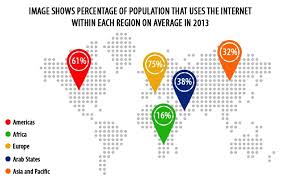
Background
 The proliferation of computing is expanding very quickly, and not all countries, especially developing countries, are able to keep up with the constant changes. The term "digital divide" doesn't necessarily mean that someone does not have computing/technology; it could mean that there is simply a difference in the computing capabilities and technology to which they have access. These differences can refer to, for example, high-quality computers, fast Internet, technical assistance, or telephone services. The difference between all of these is also considered a gap.
The proliferation of computing is expanding very quickly, and not all countries, especially developing countries, are able to keep up with the constant changes. The term "digital divide" doesn't necessarily mean that someone does not have computing/technology; it could mean that there is simply a difference in the computing capabilities and technology to which they have access. These differences can refer to, for example, high-quality computers, fast Internet, technical assistance, or telephone services. The difference between all of these is also considered a gap.
 The Global Digital Divide is a special case of the digital divide. It is based in part on different rates of technology development. Guillen and Suarez state: "The Internet has developed unevenly throughout the world" [4]; with this being illustrated in the figure below. This discrepency in development has caused some countries to fall behind in technology, education, labor, democracy, and tourism. The concept of the digital divide was originally popularized in regard to the disparity in Internet access between rural and urban areas of the United States of America; the global digital divide mirrors this disparity on an international scale.
The Global Digital Divide is a special case of the digital divide. It is based in part on different rates of technology development. Guillen and Suarez state: "The Internet has developed unevenly throughout the world" [4]; with this being illustrated in the figure below. This discrepency in development has caused some countries to fall behind in technology, education, labor, democracy, and tourism. The concept of the digital divide was originally popularized in regard to the disparity in Internet access between rural and urban areas of the United States of America; the global digital divide mirrors this disparity on an international scale.
The global digital divide also contributes to the inequality of access to goods and services available through technology. Computers and the Internet provide users with improved education, which can lead to higher wages; the people living in nations with limited access are therefore disadvantaged. This global divide is often characterized as falling along what is sometimes called the north-south divide of "northern" wealthier nations and "southern" poorer ones.
Many argue that basic necessities need to be considered before achieving digital inclusion, such as an ample food supply and quality health care. Minimizing the global digital divide requires considering and addressing the following types of access:

- Physical Access - Physical access involves, "the distribution of computing/technology devices per capita.and land lines per thousands"[5]. Individuals need to obtain access to computers, landlines, and networks in order to access the Internet. This access barrier is also addressed in Article 21 of the Convention on the Rights of Persons with Disabilities by the United Nations.
- Financial Access - The cost of computing/technology devices, traffic, applications, technician and educator training, software, maintenance and infrastructures require ongoing financial means.[6]
- Socio-demographic Access - Empirical tests have identified that several socio-demographic characteristics foster or limit computing/technology access and usage. Among different countries, educational levels and income are the most powerful explanatory variables, with age being a third one.[7][6] Others, like gender, don't seem to have much of an independent effect.[8]
- Cognitive Access - In order to use computer technology, a certain level of information literacy is needed. Further challenges include information overload and the ability to find and use reliable information.
- Design Access - Computers need to be accessible to individuals with different learning and physical abilities including complying with Section 508 of the Rehabilitation Act as amended by the Workforce Investment Act of 1998 in the United States.
- Institutional Access - In illustrating institutional access, Wilson states "the numbers of users are greatly affected by whether access is offered only through individual homes or whether it is offered through schools, community centers, religious institutions, cybercafés, or post offices, especially in poor countries where computer access at work or home is highly limited" [5].
- Political Access - Guillen & Suarez argue that that "democratic political regimes enable a faster growth of the Internet than authoritarian or totalitarian regimes"[4]. The Internet is considered a form of e-democracy and attempting to control what citizens can or cannot view is in contradiction to this. Recently situations in Iran and China have denied people the ability to access certain website and disseminate information. Iran has also prohibited the use of high-speed Internet in the country and has removed many satellite dishes in order to prevent the influence of western culture, such as music and television.[8]
- Cultural Access - Many experts claim that bridging the digital divide is not sufficient and that the images and language needed to be conveyed in a language and images that can be read across different cultural lines.[13]